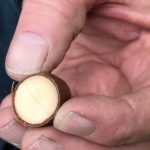by Marion Patterson | May 12, 2022 | Birds, Garden/Yard, Nature, Trees
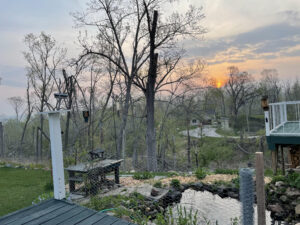 The distant view and the feel are “Hot August Days.” The near view and sounds are mid-May. With this hot weather, the trees have popped, the fruit trees are in full bloom, and the early garden plants emerging after the cooler and damp weather. We may break a century-old heat record today.
The distant view and the feel are “Hot August Days.” The near view and sounds are mid-May. With this hot weather, the trees have popped, the fruit trees are in full bloom, and the early garden plants emerging after the cooler and damp weather. We may break a century-old heat record today.
Two days ago we had the woodstove running. Now the air conditioner!
Notice the haze in the distance and the sun rising in the east – still six weeks from the Summer Solstice. Humidity levels are high. Winds are calmer after the front blew in.
The trees show emerging leaves and catkins. Insects work the fruit trees and low-growing spring flowers.
Birds are everywhere singing, courting, mating, and building nests. Amazing transformation in two days.
-
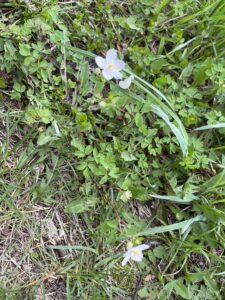
-
Deeply cut leaves of the false rue anemone.
-
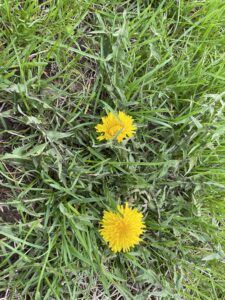
-
going at $8.00 per gallon at wineries, picking blooms from safe places is good income.
-

-
the oak popped out in one day with the heat.
-

-
birds forage in emerging buds.
by Winding Pathways | May 5, 2022 | (Sub)Urban Homesteading, Birds, Nature
When recently walking for exercise at a cemetery our ears and then eyes alerted us to an amazing urban sound and sight.
Like most people, while walking we mostly watch the ground in front of us with occasional glances to the side and way forward. We don’t LOOK UP often enough, but the high-pitched cry was fascinating enough to stop us in our tracks to enjoy an upward view of a pair of ospreys circling their nest on the top of a cell phone tower.
We weren’t out in the country where we might expect a large raptor to nest. Rather the nest was above a lumber yard, restaurants, a liquor store, and a busy road.
Osprey
Ospreys are sometimes called fish hawks for their ability to catch and dine on fish. The nest we discovered was near a fish-swarming stream. People worldwide can enjoy this beautiful aerialist, as it has one of the largest ranges of any bird. It’s at home in Europe, Asia, Australia, Africa, and both North and South America.
Other Large Migrating Birds
LOOK UP. When we sit on our back deck LOOKING UP lets us spot migrating geese, pelicans, vultures, and even swans that we’d never see at ground level on our property. LOOKING UP lets us watch a pair of turkey vultures nesting in a huge hollow basswood near our house. LOOKING UP helps us spot massive bald eagle nests in the country and even in town. They seem to prefer nesting at the top of tall cottonwoods relatively close to water.
Ospreys are huge raptors and adept aerialists able to swoop down and pluck a fish from the water. They are pointy winged birds colored in black and white. Bald eagles are even bigger and also fish lovers. Supposedly our national bird sometimes hassles a fish-carrying osprey until it drops lunch that’s quickly recovered by the eagle.
National Bird
We’ve not seen this happen but apparently, our national bird is a skilled thief. Watch this video and note how the fishermen first hear the bird cries, spot the birds, put down their poles and catch the action on their phones. Listen, Look, Enjoy!
So, when walking or even sitting on the deck LOOK UP!
by Winding Pathways | Apr 28, 2022 | (Sub)Urban Homesteading, Chickens, Foraging, Garden/Yard, Garden/Yard, Weeds
We are shocked by the rise of many prices, especially food. Fortunately, we mute the cost by finding or growing groceries here at Winding Pathways. We’re lucky to own two acres, but folks living on tiny lots can produce an amazing amount of food, even if they aren’t passionate gardeners.
In a nutshell here’s what we do to tame grocery bills:
Foraging
It’s ironic that many people consider the most delicious and easy wild foods pests and spend time and money trying to eliminate them. We eat ‘em. Books and websites, including Winding Pathways, share tips on finding, identifying, harvesting, cooking, and eating wild foods. Caveat: ALWAYS check that you have the correct plant, gather from unpolluted places, and consume only a small amount initially to be sure your body accepts the wild edible.
Here are our favorites:
Gardening
We’re not passionate gardeners and we don’t can or freeze vegetables, so here’s what we do:
- Succession plant: Our small garden yields an enormous amount of food. We don’t let a square foot be idle. When summer’s heat turns lettuce bitter, we pull it, feed it to our chickens, and plant beans or another heat-loving crop. Same with other crops that grow quickly and then fade.
- Use vertical space: Pole beans, for example, produce much more food per square foot than bush beans, so we choose climbers and use vertical space. We have the pole high enough to reach up and pull off the beans.
- Grow dwarfs: Some cucumber varieties, for example, are “bush” type, meaning they produce a crop without long vines that consume plenty of space.
- Think of winter eating: Because we lack freezer space and don’t can food, we plant vegetables that need little care during the growing season and store them until late winter without being canned or frozen. Here’s our list:
-
- Winter squash. Pick them, let them curet, and store them in a cool spot. They keep for months. Same with pie pumpkins.
- Carrots and parsnips. In late fall we smother the plants with a thick blanket of dry leaves or straw that keeps the ground from freezing. We’ve harvested carrots in January by brushing away snow and peeling back the mulch and pulling them.
- Sweet potatoes. They love the South’s climate yet grow well up north.
We carefully dig them in the fall, cure them, and store them like winter squash.
-

-
Sweet potatoes are a healthy vegetable.
-

-
Winter Squash vary in color, texture, shape and size.
Chickens
We can’t imagine living without a small chicken flock. Our six to 12 hens gift us a couple of dozen eggs a week. Their manure fertilizes the garden and garden weeds are a great hen chow. During warm months our hens forage in their large run eating bugs, worms, and weeds and transforming them into eggs. Sometimes we even stew down an old hen.
-

-
In the summer hens find plenty to eat.
-
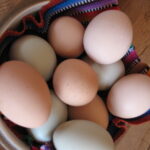
-
The chickens kept on laying eggs.
-

-
Chickens efficiently recycle squash seeds to eggs.
Wildlife
Lots of folks don’t like hunting. For us harvesting a deer is a form of food gathering, not recreation. After all, deer are free-ranging, local, and organic. Fortunately, we’re able to hunt on our property and convert a deer into delicious meat. We also enjoy eating panfish.
Like most folks, we can’t grow or forage all our food but much comes from the yard and area. It takes knowledge and investment in elbow grease but trims the food budget. Perhaps even better, knowing how to find and grow food makes us feel less vulnerable to national disruptions that make food either hard to get or expensive.
by Winding Pathways | Apr 21, 2022 | (Sub)Urban Homesteading, Chickens, Hoover's Hatchery
Frigid April weather threatened the lives of 90 baby chicks.
We had agreed to brood 75 rooster chicks for the Rodale Institute. In past years we have brooded a dozen to 25 chicks for our own flock. That was easy. We could brood them in a big cardboard box, and if it was cold we situated the brooder in the basement where the temperature was already warm. A heat lamp easily boosted it to the nearly 100 degrees hatchlings need.
We’d ordered Rodale’s chicks and 15 pullets for us from Hoover’s Hatchery to arrive on April 7. That’s usually an ideal time, as spring’s temperatures rapidly rise. So, by May, chicks can go out into the non-heated coop with only a heat lamp to take the chill off on cool nights.
-

-
When temperatures too cool, chicks huddle to stay warm.
-

-
Dip the chick’s beak in water so it knows where to drink.
-
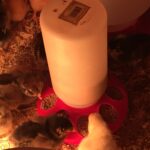
-
Chicks eat, drink, sleep and poop.
Wind and Cold
This year a cold front brought snow and wind the day before Kelsey Spotts was to deliver the chicks from Hoover’s Hatchery. Because we were brooding 90 chicks, we made a big brooder in the unheated barn. The weather was so cold that even with three heat lamps it was just too cold in the big brooder. With just a day before the babies were to arrive, we had a crisis.
Nature’s Way Is More Simple
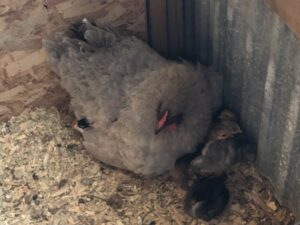
Mama hens are the natural way to brood and raise chicks.
For thousands of years, broody hens patiently sat for 21 days on fertile eggs. Then, on that magical day when they hatched, mamas hover over them to keep them toasty warm from their body heat. Even if a cold snap arrived hens keep their babies warm. Today, most chicks lack a mother. A brooder keeps them warm but ……. ours was too cold.
We scrambled. Fortunately, we had scrounged crates from a wood scrap pile outside a business that welcomes people to take and recycle their discarded wood. We used the wood to craft a temporary brooder in our wood stove heated cabin and installed two heat lamps. Presto, the temperature hovered just at the 100 degrees the chicks need.
The next day Kelsey delivered all 90 chicks. They moved right in and immediately started eating, drinking, peeping, and pooping. Now, a week later, the weather hasn’t warmed much, and the chicks remain in the temporary brooder in the cabin. They’re growing and feathers are forming.
Warming Trends and Chick Growth
The forecast next week promises a warming trend. So, as soon as the barn brooder comes up to about 90 degrees the chicks move there. Why 90 instead of 100? When chicks hatch, they need the full warmth but as they age their temperature needs drops by about five degrees a week. So, by the time they are six weeks old, they will be comfortable at a balmy 70 degrees, and that’s a common May temperature. No more need for artificial heat or a brooder.
-
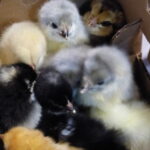
-
Hoover’s Hatchery keeps chicks safe….
-
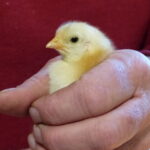
-
Handle chicks delicately.
-
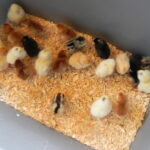
-
Chicks move around freely.
Rodale will use their chicks for a research project at Etzel’s Sugar Grove Farm. Researchers will learn if chickens foraging in corn can eat enough insect pests to eliminate the need for pesticides, and their poop will fertilize the crop.
Watch for future blogs about the chicken in corn project.
by Winding Pathways | Apr 7, 2022 | Foraging

Enjoying coffee and a latte.
Every spring we enjoy a cup of free coffee. In good years it’s coffee plus free lunch. Nope, the coffee shop doesn’t skip our bill. It’s free because we’d just left the Marion Iron Company with cold cash after selling a year’s accumulation of scrounged metal.
Recycling, as most people know, is relatively new, but scrap yards have been buying and recycling metal for centuries. Here’s what we do to earn a few bucks.
We scrounge free pallets from businesses that toss them in heaps to be hauled to the landfill. Our Milwaukee circular saw cuts them into chunks that make outstanding wood stove kindling and fuel for outdoor campfires. When the ashes have cooled, we run a magnet through them, retrieve the nails, and store them in old metal paint buckets.
Picking Up Metal
Whenever we spot a chunk of metal along the road or in a parking lot, we pick it up and add it to our scrap metal trove. In some years we’ll have a couple of hundred pounds of nails and random scrap to sell.
-

-
We add our metal to th3e pile.
-

-
Big claws grip metal.
-

-
This metal may have crossed the ocean many times.
We like selling scrap. It generates money but mostly just feels good to see our nails recycled. We envy them for their travels. Many nails are made in China and make the long journey across the ocean to eventually be used by pallet companies. We sell the reclaimed nails at the scrap yard. They ship them to a company near Chicago that melts them into solid blocks of steel. Those are bought by all sorts of companies that make thousands of products from them. So, our old nails may end up as a car, pocket knife, re-bar, or who knows what? They might even cross the ocean to be sold to a foreign steel manufacturer.
Like-Minded Friends
We recently learned we’re not alone. Friend, Kurt Rogahn, saves bits of aluminum. When a small pile accumulates off to recycling, they go.
We’re not getting rich selling metal. The price per pound at the scrap yard varies from year to year. If we have plenty to sell and if the price is high our old nails buy us an elegant lunch. In a poor year, it’s free coffee.
Scrap steel and iron usually bring the lowest price per pound. Aluminum, copper, and brass sell for much more.

Cold cash for scrap.
After writing the above we delivered our metal to Marion Iron. It weighed 80 pounds, and we left with $7.00! Minutes later we were at Mr. Beans Coffee shop just down the road. Our cold cash bought us coffee and a bit more.
Recycling is the right thing to do with a free coffee bonus.
by Winding Pathways | Mar 31, 2022 | (Sub)Urban Homesteading, Chickens, Reflections/Profiles
Keep the Photos!
An old photo or letter can bring back memories. That happened to Rich recently and helped him recognize both good parenting and a lifelong passion.
Rich was sorting through a stack of family documents when he discovered a paper his mother wrote in his “baby” book. Written in 1959, when Rich was nine, it stated that he wanted to be a chicken farmer! Of all things for a kid growing up in suburban New Jersey to say.
Rich became fascinated with chickens while only four or five years old. By the time his mother wrote in the book he had learned many chicken breeds. Another letter, dated May 5, 1959, was written as an exercise in his elementary school. The teacher was teaching students letter writing. Rich’s note to his mother said:
Thank you for taking me to the chicken farm. Now I know what a black hen looks like. I now know why one costs more than a Leghorn. I’m going to cook breakfast for you. Happy Mother’s Day. Love, Rich
A Budding Entrepreneur
A third document is an account of how many eggs his hens laid each day and a bill presented to a customer. 65 cents for a dozen in 1960. Adjusted for inflation that dozen would cost $6.50 today.
-

-
Dreaming of the future
-
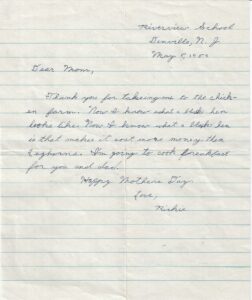
-
Expressing appreciation
-
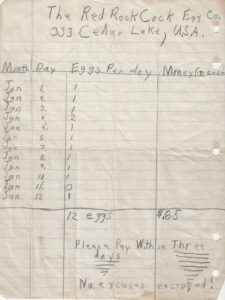
-
Learning math and writing.
A pair of photos show 13-year-old Rich at his junior high school science fairs. One science project was titled, The Effect of Vitamin E on the Hatchability of Chicken Eggs, and the other demonstrated an incubator.
-

-
A science project
-

-
Scientific studies.
What Do These Documents Signify?
- Great parenting. It must have seemed weird to his parents that their young child had such an unusual passion, but they helped, learned, and encouraged.
- Chickens helped teach math, animal care, writing, business, and research methods.
- Chickens became a lifelong passion.
Rich encourages parents to encourage their children’s passions. They might lead to lifelong hobbies and, perhaps, even a career.
Update on Careers
Rich never became a chicken farmer, per se, but he is co-owner of Winding Pathways where we encourage people to be creative in how they interact with nature and to consider backyard chicken raising. He developed another passion, fish, and earned a degree in fishery biology, and served as a biologist in Alaska.
 The distant view and the feel are “Hot August Days.” The near view and sounds are mid-May. With this hot weather, the trees have popped, the fruit trees are in full bloom, and the early garden plants emerging after the cooler and damp weather. We may break a century-old heat record today.
The distant view and the feel are “Hot August Days.” The near view and sounds are mid-May. With this hot weather, the trees have popped, the fruit trees are in full bloom, and the early garden plants emerging after the cooler and damp weather. We may break a century-old heat record today.






